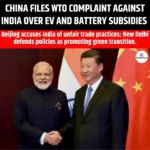China Resumes Rare Earth Magnet Exports to India
|
General Studies Paper II: India and its Neighbourhood, Groupings & Agreements Involving India and/or Affecting India’s Interests |
Why in News?
Recently China has resumed rare earth magnet exports to India. The decision brings relief for industries that depend on these materials. It also signals a positive shift in trade relations between India and China.
What Are Rare Earth Magnets and Why Do They Matter?
- About: Rare earth magnets are powerful permanent magnets produced from specific elements of the rare earth family of metals. These metals include neodymium, praseodymium, samarium and dysprosium. They are called “rare” because they are difficult to extract and process from ores.
- The first commercial use of these magnets became visible in the 1980s when scientists in Japan developed strong neodymium magnets for industrial purposes.
-
-
- The key reason rare earth magnets matter is their exceptional magnetic force. A magnet made of neodymium metal can hold hundreds of times its own weight.
- They create a strong and stable magnetic field that does not lose intensity quickly.
-
- Uses:
-
-
- Electronics: One of the largest areas where these magnets are used is consumer electronics. Smartphones, laptops, headphones and modern cameras use tiny rare earth magnets in speakers. By 2024, more than 1.5 billion smartphones sold globally had components made from rare earth magnets.
-
- Renewable Energy: Rare earth magnets have become central to the renewable energy revolution. Wind turbines use powerful neodymium magnets in their generators which reduce energy loss and improve its efficiency. A single large wind turbine may need up to 600 kilograms of rare earth magnets.
- Electric Vehicles: Electric motors in EVs use neodymium and dysprosium magnets for efficiency and longer battery life. Without these magnets the motor would be bigger and heavier. Reports in 2023 showed that each electric car requires nearly 2 to 3 kilograms of these magnets.
- Defence: Fighter jets, drones, guided missiles and radar systems all rely on rare earth magnets. They help in miniaturising equipment while keeping it reliable. Satellites also need them for navigation and control systems.
- Healthcare: Magnetic Resonance Imaging (MRI) machines use strong magnets to create detailed images of the human body. Neodymium magnets also appear in prosthetics and dental tools. By 2025, healthcare remains one of the fastest growing sectors for rare earth magnet use worldwide.
China’s Role in the Global Rare Earth Supply Chain
- China maintains overwhelming control over the global rare earth market and shapes supply dynamics worldwide.
- China produced about 69% of global rare earth output in recent years. This dominance affects global markets and policy.
- The country handles nearly 90% of global rare earth refining, making it the central hub for high-technology applications.
- China holds sizable known rare earth reserves. Common varieties of these magnets include neodymium-iron-boron and samarium-cobalt, both valued for their strength and efficiency.
- In 2024, China recorded unprecedented export volumes of rare earth magnets, reinforcing its role as the leading supplier. The country mined the largest volumes of rare earth concentrates in 2023 and 2024.
- The nation also dominates the processing of heavy rare earths such as dysprosium and terbium, which are critical for advanced technologies. China produces most industrial permanent magnets.
- China has advanced cutting-edge technology in this field, enabling the production of high-quality rare earth products at reduced costs for global export.
- China’s dominant position in the international rare earth market grants it significant control over production, pricing, and export activities.
India’s Dependence on Rare Earth Magnets
- India depends heavily on rare earth magnets. During 2024–25, India imported about 53,700 tonnes of permanent magnets, with the majority sourced from overseas. That figure nearly doubled from approximately 28,700 tonnes in the previous year.
- More than 90% of these imports originated from China, underscoring India’s strong dependency on a single supplier.
- India ranks third globally with reserves of 6.9 million tonnes measured in rare earth oxide equivalent.
- India spent about US $291 million on rare earth magnet imports in FY 25. That amount rose sharply from an annual average of US $249 million over the prior four years.
- Additionally, trade value estimates show around US $200 million worth of imports in FY 25 for automotive and related uses, again with about 85 % sourced from China.
- Despite this, the country holds only about 6% of global reserves and contributes barely 1% of global output.
- Automotive, electronics, renewable energy, and defence sectors all rely on rare earth magnets. When China imposed export restrictions in April 2025, Indian automakers warned of possible production halts within days.
Impact of Export Resumption on Key Sectors
-
- Automotive Sector: For FY 2025-26, India’s automotive industry alone is expected to need nearly 870 tonnes of rare earth magnets to sustain production. The earlier Chinese export restrictions slowed both EV and ICE vehicle production. The resumption of exports prevents supply bottlenecks and stabilizes assembly lines. This change directly supports India’s EV penetration goal of 30% sales by 2030, set under the FAME-II policy.
- Renewable Energy: Wind turbines and solar systems require strong magnets for high-efficiency generators and tracking. A large wind turbine can use up to 600 kilograms of rare earth magnets in its components. The resumption of Chinese exports secures the parts pipeline for both new installations and ongoing maintenance. This move is crucial as India aims to achieve 500 GW of renewable capacity by 2030 under its climate goals.
- Consumer Electronics: Smartphones, laptops, headphones, and industrial motors use miniaturized magnets for speakers, drives, and sensors. In 2024, over 1.4 billion smartphones worldwide included rare earth magnet components. Stabilized imports safeguard production worth billions in consumer electronics and machinery, protecting jobs and ensuring domestic availability without sharp price hikes.
Way Forward
- India should diversify imports by building partnerships with Vietnam, Brazil, and Russia until domestic production becomes viable. This diversification will reduce risk from single-country dependence and provide stable supply for critical industries.
- India should expedite the domestic manufacturing of rare earth magnets. The government already announced a ₹1,345 crore incentive scheme in June 2025 to promote domestic magnet manufacturing. Such targeted incentives will attract private investment and technology transfer.
- India should establish a full domestic value chain covering mining, refining, processing, and magnet manufacturing. This initiative will guarantee a secure supply chain, assisting industries and preventing potential disruptions.
- India should enhance policy support by providing financial incentives associated with production. Tax benefits, subsidies, and low-cost financing can motivate companies to invest in advanced magnet production technologies and create long-term competitiveness.
- Furthermore, India should promote public-private partnerships to establish rare earth processing facilities and magnet production clusters throughout industrial areas. Collaboration with private firms will bring innovation, while the government will provide infrastructure.
- India should expand R&D investment in rare earth recycling and substitution technologies. By supporting universities and research labs, the country can reduce dependence on imports and improve sustainability in the long run.
- India should integrate rare earth strategy with clean energy and EV goals. Securing magnets for wind turbines and electric motors will ensure the nation meets its 500 GW renewable energy target by 2030.








